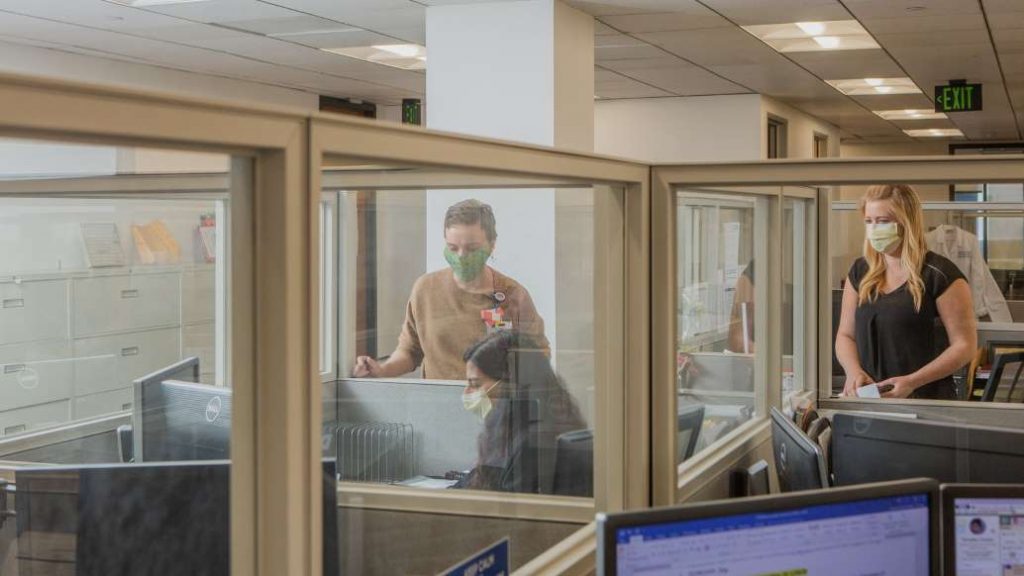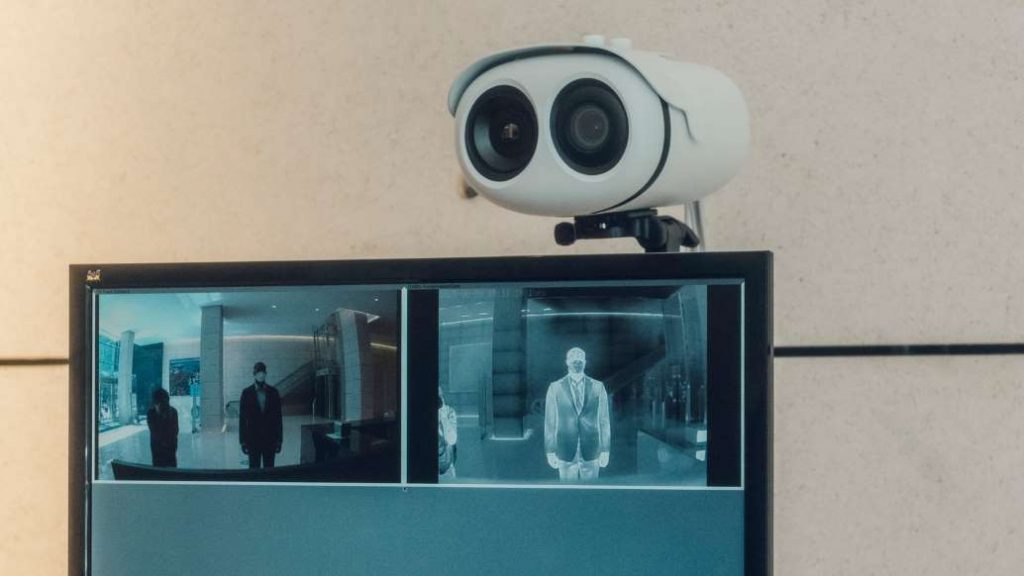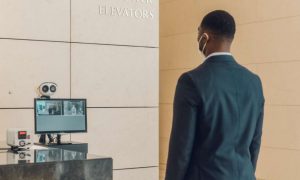Truework, an income verification start-up, recently introduced software to help employers keep track of their workers’ health status.
Gensler, an architecture and design firm, has a workplace floor-planning app that generates social-distancing layouts for desks and other office furniture.
PwC, the professional services firm, is using technology that it originally developed to track inventory for a new contact-tracing system that logs employee interactions so workers can be notified in the event of exposure to the coronavirus.
With companies pressing to figure out how to safely reopen workplaces, makers of everything from office furniture to smart ventilation systems are rushing to sell them products and services marketed as solutions. Some companies, like makers of thermal cameras that sense skin temperature, are rebranding their wares as virus-containment fever-scanning products. Others are creating entirely new services.
And they have a captive market. To protect employees and reduce liability for virus outbreaks at work, companies are racing to comply with public health guidelines on issues like employee screening and social distancing. In the United States, the market for contact-tracing technologies for employers could soon be worth $4 billion annually, according to estimates from International Data Corporation, a market research firm.
But the preventive tools and pandemic workplace rules are so new — as is the emerging science on the virus — that it is too soon to tell how well, or if, they work.
“These are all untested theories and methods right now,” said Laura Becker, a research manager focusing on employee experience at I.D.C. “What is going to be the most effective component of all of these work force return strategies? We don’t know.”
The Lobby
When workers eventually return to the office, they may find that the lobby resembles an airport security checkpoint. At least that’s the vision that Kastle Systems, a 48-year-old Falls Church, Va., company that designs, installs and monitors security systems for several thousand commercial buildings, recently began marketing to its clients.
Businesses that use the company’s coronavirus management system, KastleSafeSpaces, may ask employees to download an app that will automatically open entrance doors for people eligible to come to the office. Workers who fill out a health screening questionnaire ahead of time may proceed to a lobby fast lane to have their temperatures checked. Those who have been asked to stay home because they recently tested positive for coronavirus may go on a kind of no-fly list and find that doors will automatically stay closed for them.
“The idea is really to create this profile where you can identify who is known safe, who’s known not safe and then who needs to be screened when they get in,” said Mark D. Ein, the chairman of Kastle. “It’s a little bit like airports where you have Clear precheck or regular check, depending on people’s profile.”
Clear, the biometric identification company known for its air-traveler identification service, recently introduced a system called Health Pass for office buildings, restaurants, retailers, cruise ships and sports arenas. It will use facial recognition to confirm employees’ identities and vet worker-provided health information — such as symptom data and verified test results — so they can be cleared to enter workplaces. Caryn Seidman-Becker, Clear’s chief executive, said this kind of multilayered approach to entry screening could help reduce risk for employers and create a safer working environment.
The Elevators
Since coronavirus particles can stick around for hours or days, vendors are rushing to repurpose technologies to reduce the spread of the droplets. Kastle said it was modifying an app that can automatically open office doors to allow employees to call an elevator and indicate which floor they want to go to without touching any buttons.
Jennifer Burns, senior vice president of property management and operations at Monday Properties, a commercial real estate owner, operator and developer, said her company has limited elevator capacity to four people at a time, asked employees going to higher floors to go to the back while riding and installed markers showing where people should stand. As an interim measure, she said, Monday Properties has installed self-cleaning antimicrobial covers, made by a Virginia company called NanoTouch, on elevator buttons for additional protection. Kastus, a company in Dublin, is also marketing its antimicrobial coatings to combat the spread of coronavirus.

The Office Layout
Steelcase, one of the largest manufacturers of office furniture, has long created and installed office desk systems designed to foster greater collaboration by pushing employees closer together and lowering partitions — the open office.
Now, companies are quickly trying to reverse that trend in a low-cost and flexible way. They want to remove chairs and desks and install screens or other dividers between remaining desks, said Allan Smith, a vice president for global marketing for Steelcase.
Office lockers are hot sellers, said Lori Gee, a vice president of client workplace performance for the furniture design company Herman Miller, which works with many Fortune 100 companies. Employees will have their own lockers where they will stow much — if not all — of their personal belongings and collect their personal protective equipment kits.
The Morning Meeting
The days of crowding into a narrow glass conference room are over.
Most conference rooms are designed with narrow layouts, which means employees have to break social distancing just to squeeze past co-workers to get to their seats. “There’s going to have to be a total reboot on what conference rooms mean to organizations,” Ms. Gee said.
Instead, smaller group meetings will be held with employees spaced apart on the clusters of couches and chairs that have popped up in offices in recent years.
But companies are seeking to replace the sofas upholstered in soft, luxurious fabrics with something more durable. “One of our biggest requests for those spaces are durable, super-fast color fabrics that they can, essentially, pour straight bleach on every single night,” Mr. Smith of Steelcase said. “They’re also looking to add white boards and technology to these spaces.”
The Coffee Break
Say goodbye to crowding around the coffee machine at midmorning to talk about the latest Netflix show you binged.
Social distancing requirements will be difficult to manage in any space where there is an opportunity for people to stand and mingle, said David Bailey, the chief executive officer of corporate services for the French food services giant Sodexo.
Instead, Sodexo has developed an app called Twelve that allows corporate employee to pre-order and pay for their morning coffee and doughnuts.
“You don’t have to go to the cafeteria to pick it up,” Mr. Bailey said. “Companies are spreading pickup locations to three or four locations in the building. And the app uses an algorithm that manages the time periods to make sure there is no crowding.”
Lunch
Over the past decade, upscale corporate cafeterias have increasingly featured sushi bars, grass-fed made-to-order hamburgers, freshly made quinoa-and-kale salads, all overseen by former chefs at top restaurants.
Now, many of these on-site cafeterias are likely to disappear.
“Even before this happened, a lot of organizations were already looking at the cost of real estate and the cost of the cafeteria and wondering if they needed it as a large percentage of their employees were working one or two days from home,” Mr. Bailey said. “Now, we’re seeing a big change in food delivery, away from on-site cafeteria model to a commissary delivery model.” Using an app like Twelve, employees can pre-order and pay for sandwiches and salads and collect them when they are delivered.

Employee Tracking and Contact Tracing
Vendors are rushing to sell companies smartphone apps, wrist bands and key fobs that automatically record employees’ contact with one another in the workplace, to prepare for possible outbreaks of coronavirus.
“This terribly manual process of contact tracing: essentially it’s a phone tree, and that’s where the technology was when people started thinking about it; we’ve since moved it into the modern age,” said Rob Mesirow, a partner in connected solutions at PwC.
In May, PwC introduced a smartphone app for employers that uses Bluetooth signals, Wi-Fi, GPS and other data to track where employees go around the office, who they come into contact with and for how long. The idea is to enable human resources or corporate security managers to quickly access the data in the event of a workplace outbreak and notify employees who may have been exposed.
Microshare, a software company in Philadelphia that uses sensors to monitor environmental factors — like indoor air quality and occupancy — for offices and manufacturing plants, is marketing a different kind of contact-tracing system. It is adapting Bluetooth technology that it originally developed to track the locations of wheelchairs and beds in hospitals for tracking employees.
Employees will wear wristbands or carry credit card-size badges that collect signals about their whereabouts and proximity to one another; that data is sent to devices that transmit it to the cloud. Microshare said employers could also use its system to identify spots where infected workers may have recently gathered, enabling companies to shut down specific areas, rather than an entire building, for deep cleaning.
The badges may appeal to secure facilities or factories where employees are not allowed to bring their personal phones, as well as to people who would rather not have their employers track them on their smartphones.
“Asking you to put something on my phone, that’s a really slippery slope,” said Ron Rock, the chief executive of Microshare. But even employee-tracking wristbands and badges raise questions about increased prying by employers, he said. “You start to come up against: Is somebody going to the bathroom too often? Is somebody going to the cafeteria too often? Is somebody smoking too much? Is somebody in parts of the building where they don’t belong?”
The post A Multibillion-Dollar Opportunity: Virus-Proofing the New Office appeared first on The New York Times and is written by Natasha Singer and Julie Creswell
Original source: The New York Times





